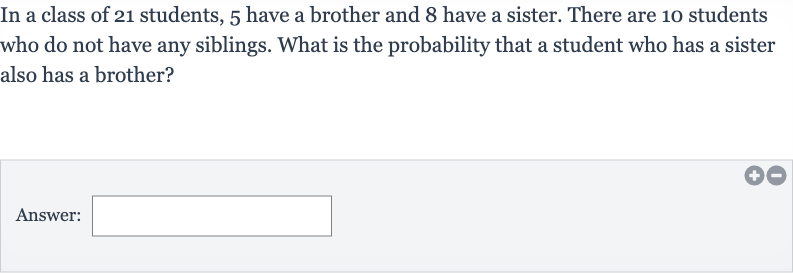AI tutor
Welcome to Bytelearn!
Let’s check out your problem:

In a class of students, have a brother and have a sister. There are students who do not have any siblings. What is the probability that a student who has a sister also has a brother?Answer:
Full solution
Q. In a class of students, have a brother and have a sister. There are students who do not have any siblings. What is the probability that a student who has a sister also has a brother?Answer:
- Determine Siblings Count: First, we need to determine the number of students who have both a brother and a sister. Since there are students without any siblings, the remaining students must have at least one sibling. We subtract the number of students without siblings from the total number of students to find the number of students with siblings. students - students without siblings = students with siblings.
- Find Overlap: Next, we know that students have a brother and have a sister. However, this does not tell us directly how many have both, as some students could be counted in both groups. We need to find the overlap between the two groups.Since there are students with siblings and more than students if we add those with a brother and those with a sister (), there must be an overlap.
- Calculate Probability: To find the overlap, we can use the principle of inclusion-exclusion. We add the number of students with a brother and the number of students with a sister, then subtract the total number of students with siblings.Overlap (students with both a brother and a sister) = (students with a brother) + (students with a sister) - (students with siblings)Overlap students.
- Simplify Fraction: Now, we can calculate the probability that a student who has a sister also has a brother. This is the number of students with both a brother and a sister divided by the number of students with a sister.Probability = Probability =
- Simplify Fraction: Now, we can calculate the probability that a student who has a sister also has a brother. This is the number of students with both a brother and a sister divided by the number of students with a sister.Probability = Probability = Finally, we simplify the fraction to get the probability.Probability =
More problems from Find probabilities using the binomial distribution
QuestionGet tutor help
QuestionGet tutor help
QuestionGet tutor help
QuestionGet tutor help
QuestionGet tutor help
QuestionGet tutor help
QuestionGet tutor help
QuestionGet tutor help
QuestionGet tutor help
QuestionGet tutor help
